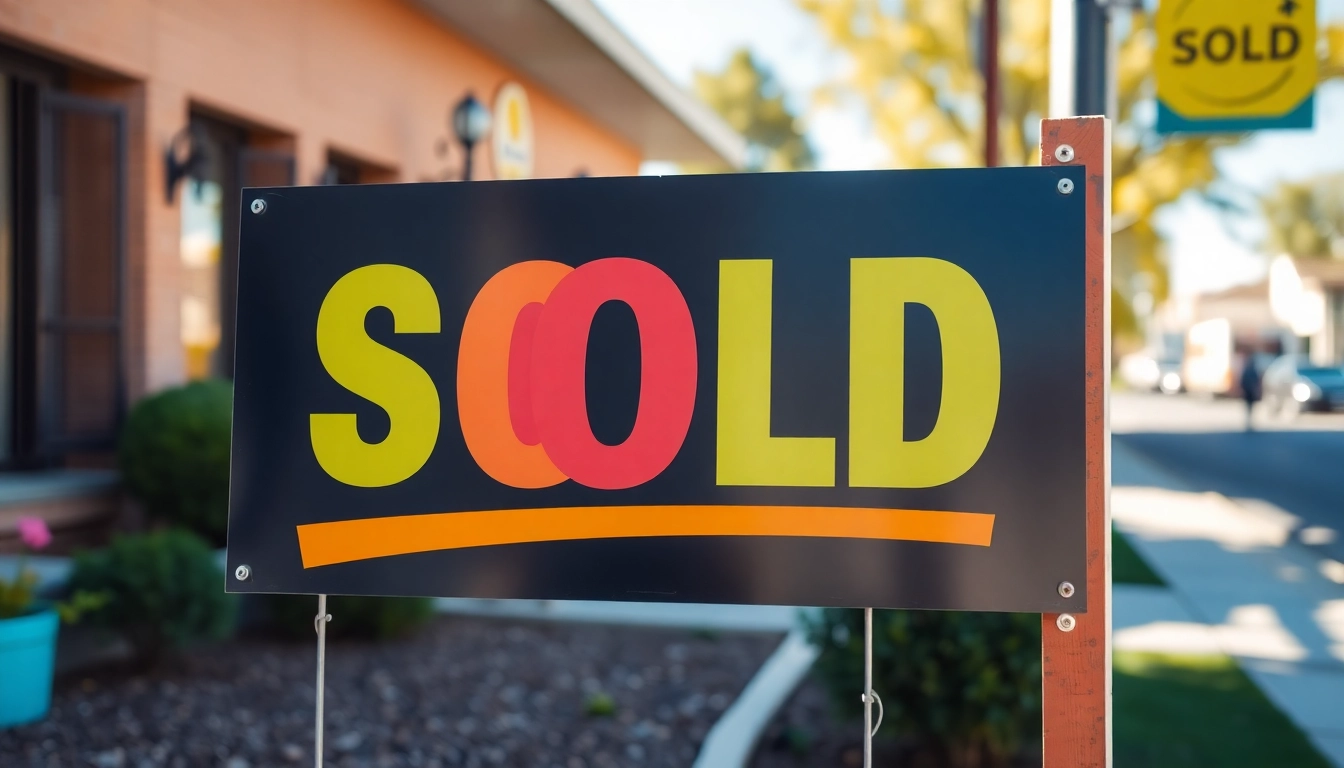Maximizing Property Sales: The Art and Science of Effective Sold Signs
In the competitive world of real estate, every detail counts when it comes to attracting potential buyers and closing deals swiftly. Among these details, the humble sold sign stands out as an essential marketing tool. While it may seem like a simple marker indicating a property’s sale, a well-designed, strategically placed sold sign can significantly influence buyer perception, enhance branding, and ultimately accelerate the sales process. This comprehensive guide explores the vital role of sold signs, how to design and customize them for maximum impact, effective placement strategies, and methods to measure their success—empowering real estate professionals and marketers to leverage this small but powerful asset effectively.
Understanding the Importance of a Well-Designed Sold Sign
Role in Real Estate Marketing
In real estate marketing, visibility is paramount. A compelling sold sign acts as both a visual confirmation of a property’s success and a marketing extension for the agent or agency. It serves multiple functions: signaling to neighbors and passersby that a property has been sold, building credibility for the agent, and enticing potential clients who may be interested in similar properties.
Studies show that properties with prominent and professional signage generate higher visibility, which can lead to more inquiries and future listings. A high-quality sold sign encapsulates branding, provides contact information, and creates a sense of trust and professionalism. It transforms a passive announcement into an active marketing tool that continuously works for the agent even after the deal closes.
Impact on Buyer Perception
Buyers often interpret a sold sign as a sign of a thriving real estate market and a reputable agent. Such signs act as social proof—indicating that other buyers have invested in the area and that the agent has a track record of successful sales. When strategically designed with clear messaging and branding, a sold sign can reassure prospective buyers about market activity and the agent’s credibility.
Moreover, a well-crafted sign can convey subtle messages about the neighborhood’s desirability and market stability, influencing buyer confidence. Conversely, poorly designed or generic signs may diminish perceived professionalism, potentially deterring engagement. Therefore, the visual and informational quality of the sold sign directly impacts its effectiveness in shaping buyer perceptions.
Key Elements of Effective Sold Signs
- Clear Visibility: Use high-contrast colors and legible fonts to ensure the sign can be read from a distance.
- Concise Messaging: Keep text minimal—using words like “Sold,” “Just Sold,” or “Welcome Home” effectively communicates the status.
- Branding: Prominently display the real estate agent or agency’s logo and contact details for future engagement.
- Durable Materials: Outdoor weather resistance ensures the sign remains intact and professional-looking over time.
- Strategic Placement: Positioning the sign where it maximizes exposure to foot and vehicle traffic enhances visibility.
Designing a Sold Sign That Gets Noticed
Choosing the Right Colors and Fonts
Color psychology plays a crucial role in sign visibility and perception. Bright, contrasting colors such as red, yellow, or orange paired with dark text can draw attention effectively. For example, a red “Sold” banner on a white or green background instantly catches the eye. Fonts should be bold, sans-serif, and large enough to be readable from a distance—avoid overly decorative or thin-type fonts that may diminish clarity.
Consistency in branding colors reinforces recognition and professionalism. Consider your agency’s color palette and ensure your sold sign aligns with your overall branding strategy for maximum impact.
Including Essential Information
While the primary message is “Sold,” additional details can boost future marketing efforts. Include your contact number, website, or social media handle discreetly on the sign. If space allows, adding a tagline such as “Another Success,” or “Ready to Help You Find Your Dream Home” can reinforce your brand message. Custom QR codes linking to listings or testimonials can also be integrated for tech-savvy audiences. The key is to balance informativeness without cluttering the design.
Using Durable Materials for Outdoor Visibility
Sold signs often stay outside for weeks or months, exposed to rain, sun, and wind. Selecting durable materials—such as corrugated plastic, aluminum, or weather-resistant vinyl—ensures longevity. Matte finishes reduce glare, and UV coatings prevent fading. Reinforced stakes or mounting hardware guarantee stability in various weather conditions. Investing in high-quality materials reduces replacement costs and maintains a professional appearance throughout the sales cycle.
Customization Options for Increased Branding
Adding Logos and Contact Details
Brand identity is critical in real estate. Embedding your logo on the sold sign distinguishes your marketing from competitors and builds brand recognition. Incorporate your contact number, email, or website URL in a prominent position. Some agents opt for magnetic or adhesive overlays that can be easily swapped or adjusted based on the sale or campaign focus.
Personalized Messages and Graphics
Personalization enhances engagement. Adding graphics such as house icons, directional arrows, or “Open House” banners can make signs more visually appealing. Custom messages like “Sold in 30 Days” or “Under Contract” can also create urgency and excitement. Handcrafted or artist-designed signs may add a unique touch, especially for luxury or boutique properties.
Unique Sizes and Shapes to Stand Out
Varying the size and shape of sold signs helps capture attention in different environments. Oversized signs increase visibility from afar, suitable for busy street corners. Non-traditional shapes—such as circular, rectangular with rounded edges, or custom-cut designs—can differentiate your signage from standard rectangular signs. Investing in unique shapes or sizes should align with branding goals and local regulations.
Placement and Timing for Maximum Effectiveness
Strategic Locations for Sign Visibility
Effective placement is essential. Position signs at highly-trafficked intersections, near property entrances, and in visible public spaces. Ensure signs are not obstructed by trees, parked cars, or other structures. If permissible, place signs at eye level to maximize visibility. Consider neighborhood dynamics; some areas may have regulations restricting sign placement, requiring permits or specific orientations.
Best Times to Install and Remove Signs
Timing influences visibility and perception. Install sold signs immediately after closing negotiations conclude, ideally once the property is officially under contract or sale finalized. Removing signs too early can create confusion and diminish perceived activity; leaving them up too long may reduce exclusivity. Coordinate with local regulations regarding the duration signs can be displayed, and remove signs promptly after the sale to maintain professionalism.
Compliance with Local Regulations
Local ordinances often specify size, placement, and removal deadlines for signage. Review homeowners’ association rules, city ordinances, and zoning laws to avoid penalties. Use permits where necessary and ensure signage adheres to height, size, and placement specifications. Well-informed compliance safeguards your reputation and prevents costly legal issues.
Measuring Success and Optimizing Your Sold Sign Strategy
Tracking Inquiries and Leads
Implement tracking methods such as dedicated phone numbers, unique QR codes, or web landing pages linked to the sold signs. Analyze the number of inquiries received pre- and post-installation. Use customer relationship management (CRM) systems to record how signage correlates with lead generation, helping to assess ROI and refine strategies.
Gathering Client Feedback
Solicit feedback from clients and buyers about the signage. Did they notice it? Did it influence their perception? Use surveys or informal conversations to gather insights. Positive responses reinforce current practices; negative feedback points to areas for improvement.
Adjusting Design and Placement Based on Data
Data-driven decisions allow continuous improvement. If signs in certain locations outperform others, focus efforts there. If particular colors or messages garner more attention, adapt your design accordingly. Regularly updating signage based on feedback and performance metrics ensures your strategy remains effective and relevant.


